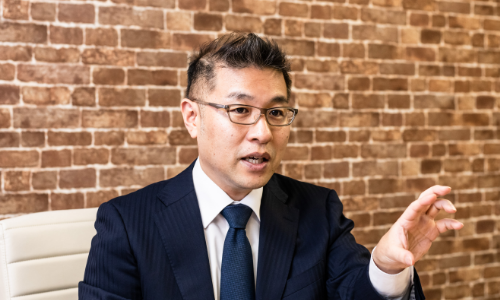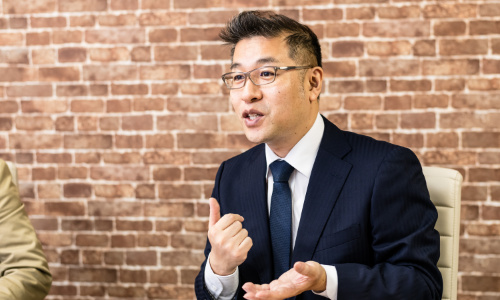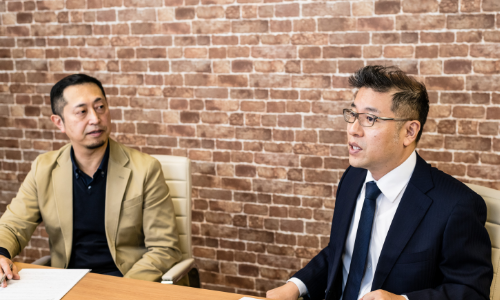
At TIS INTEC Group, we engage in CVC (Corporate Venture Capital) by making principal investments with our own funds rather than through fundraising activities. In our CVC activities, we strive to achieve growth in collaboration with startup companies in the industries and IT domains that TIS INTEC Group is engaged in. The focus of this article is Blue Innovation, a pioneer in the industrial use of drones in Japan. We interviewed Yamagishi Katsunori Yamagishi, who leads the CVC efforts at TIS, and Takayuki Kumada, President and CEO of Blue Innovation, to discuss what led to their collaboration and what kind of advantages it will bring.

We believe that in order for the drone industry to take off, “breakthroughs” in three areas need to be achieved, and Blue Innovation is unique in that it has already pinned down breakthroughs in each of these.
The first area is technological breakthroughs. This is especially true for our Blue Earth Platform (BEP), a proprietary device integration platform that enables the remote control and integration of multiple devices, including drones, robots, and sensors. We are especially proud of this technology, which is one of our most distinct advantages. BEP is a platform for drones and robotic systems. Basically, it’s like the operating system of a PC or smartphone, and it allows the coordination and control of multiple drones and robots remotely and out of sight.
Normally, commercially available drones only come with standard functions, making them difficult to employ in various use cases. For instance, inspecting along power lines or structures is actually quite difficult. In our case, however, since we have been involved in sensing technology, we developed our own sensor fusion technology that leverages this experience. By simply installing Blue Innovation’s sensor module on a commercially available drone, it allows the drone to precisely estimate its own position, facilitating not only highly accurate and effective inspections but also automatic flight in an indoor environment where automatic flight is normally difficult due to the inability to use GPS indoors. Our technology for automatic flight-based detection of power lines is the only one of its kind, and we are now receiving inquiries about it from all over the world.
The second area is legal and regulatory breakthroughs. Since its early stages in July 2014, we’ve been involved in the Japan UAS Industrial Development Association (JUIDA) , an industry-academia-government consortium for next-generation mobile vehicle systems, including drones. Since that time, we have also been serving as JUIDA’s secretariat to promote the drone industry and support market development.
As part of these activities, we have also established drone safety guidelines. This has led to progress in terms of revisions to the Revised Civil Aeronautics Act, which went into effect on December 5, 2022, and established the precedent for such guidelines. By participating in and chairing various working groups, we are also leading the world in international standardization efforts for drone-related technologies.
Our recently released BLUE SKY is another example of technological breakthrough. This is a drone flight log and information management service based on the BEP I just mentioned and is available free of charge only to JUIDA members. A recent legislative change has made it mandatory to fill out a logbook after drone flights, and BLUE SKY offers an all-in-one service that integrates all necessary drone flight management functions, from automatic generation of flight logbooks to aerial vehicle maintenance. In other words, “two breakthroughs” were used to achieve this.
The third area is drone operator breakthroughs. No matter how far automation progresses, since drones are ultimately controlled by people, nothing can happen without the drone pilots. That is why we have partnered with JUIDA, which has already licensed over 25,000 drone pilots, to focus efforts on drone pilot training and education.

Actually, when I was in graduate school, my research subject was coastal disaster prevention. I also ran a business related to coastal disaster prevention. In 2004, I launched a coastal environment consulting firm after successfully developing the world’s first “numerical model for predicting changes in coastal topography and sediment grain size.” When a coastal disaster occurs, aerial photography is very important for investigating the cause. At the time, we were using aerial photographs taken by the Geospatial Information Authority of Japan, but it was impossible to see the critical moment right after the disaster occurred. To address this, we were flying radio-controlled machines and kites equipped with cameras, but their vulnerability to the wind made stable shooting impossible, and it would be a stretch to call it a good method.
In our search for a better way to take pictures, I was introduced to Professor Shinji Suzuki of the University of Tokyo’s Department of Aerospace Engineering (currently Professor Emeritus at the University of Tokyo and Project Professor at the University of Tokyo Institute for Future Initiatives ), an authority in the aviation industry. Based on lessons learned from the Mount Osutaka plane crash disaster, he developed and tested a flying robot (today’s drone), which was basically an airplane-model radio-controlled aircraft equipped with an automatic control system. When I asked him whether this flying robot could be used to monitor coastlines, he said it sounded interesting and that we should try it together. This was right around the time that multicopters and other drones were beginning to appear. We started joint research with the University of Tokyo and were able to create Japan’s first drone-based coastal monitoring system. When Professor Suzuki and I experimented with a flying robot along the coast and I saw it returning automatically, I remember saying, “This is incredible technology!”

When we started looking seriously at Blue Innovation around 2018, they had already established a solid presence in industrial drone use. We were not focused on any particular drone model, but expected Blue Innovation’s drone business to grow significantly in the future due to the flexibility provided by the wide range of models it handled. Furthermore, as Mr. Kumada already mentioned, Blue Innovation is the leader in Japan for drone pilot safety training, has a strong global reputation, and has established the largest network of drone pilots in Japan. While drones may give the impression of fully automated flight, this level of automation is not yet possible, making pilots indispensable.

At first, it seemed like Mr. Yamagishi nonchalantly approached us on his own (laughs), but after speaking with him, we realized that he had actually done extensive research on our company and was incredibly quick to make an investment. In most cases, it takes more time, but I think that it just goes to highlight Mr. Yamagishi’s talent.
And despite the fact that venture capitalists do not often make additional investments, we were very grateful for the additional investment from TIS INTEC Group. This additional investment made it possible to broaden the scope of our operations. Another thing about the investment and collaboration is that I met directly with the executives of both companies, and given that it’s not always possible to meet and talk directly with the executives of large companies, we were very grateful that the management strategy departments of both companies were able to work together.
hank you for the compliment. Blue Innovation has been a pleasure to work with for us as well. They were well-versed in our internal processes and a great fit in many respects. We have collaborated on a number of proof-of-concept projects and hope to continue collaborating in the future to develop robotics as a TIS Intec Group service.
We are also eager to accelerate the platformization of BEP from SaaS to PaaS and look forward to continuing to work with the TIS Intec Group to bring new solutions to the world. If possible, we hope that our collaborative efforts will result in a new de facto standard or major hit.
Becoming a major hit overnight might be difficult (laughs), but we look forward to providing our clients with the new products that will result from our collaboration with Blue Innovation, and are hopeful that working together will help solve a variety of society’s challenges.